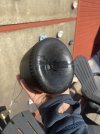Coax
Pros:
-Most likely will perform better with complex music
-Free waveguide for tweeter if the cone is favorable shape. I doubt that is the case in your selected driver.
-Still simple cabinet building
Cons:
-Still need crossover
-Will most likely cost more than 2-way woofer + tweeter
-Doppler distortion is a thing. I am not sure that applies to coaxial but it definitely applies to the entire speaker moving forward-backward.
-Many coax drivers are made with a tweeter as an afterthought. So, the entry to the cone is designed bad. Like really bad. Your driver is an example. More expensive drivers are made better (Seas, Sica etc). So the integrated "waveguide" thing which could be tremendous advantage is a tremendous disadvantage
Fullrange
Pros:
-The best sound on budget for near field listening for non-complex music. Singer + guitar is ok.
-Very good if not the best bang for the buck
-No crossover. If have EQ - no filters needed. Wire and speaker
Cons:
-Most if not all drivers will have multiple flaws. It will be impossible to select one without them for any amount of money.
-The selection of the size of the driver is as problematic as the driver itself: big one will beam at 5+ kHz, small will have no bass.
-Very sensitive to driver cone material implementation. That Pluvia is metal cone, imho big metal cones for full range is a no-go. Too many wild peak at the breakup frequency and higher. Look for smth paper or composite based
In your selection I doubt that metal cone is a way to go on cheap, and that SB coax is not well engineered. There are MANY reviews of both and more of them are not so favorable.
I would go with:
Dayton PS220 or Visaton B200 - more expensive than Pluvia but they are monsters
Any confirmed 3-4" with TABAQ like MLTL - the most fun and performance for the least amount of money. Will lack some bass for sure, and have all the flaws of small fullranges but the mid and highs will be very good. For the first time It is hard to believe how good MLTL sounds
WAW with Dayton PS95 or Vifa TC9 or any other cheap but good 2-3" fullrange + SB paper woofer 6-8" and cross at ~1000 Hz passive for smaller woofers or ~200-300Hz active with bigger. The cost will be comparable to SB coax.
The same, but 2.1 system with subwoofer. The same 8" SB paper woofer is a viable choice or go with commercial one. 70-150 EUR for subwoofer with plate amp + 50EUR for pair of fullranges is more or less comparable to your budget. The boxes for such speakers will be small and you can select from BR, fully closed, aperiodic or even 100+Hz tuned TL and so on.
Seas, Sica, Kartesian or any other properly designed coax - will cost 2x more and still need crossover. I cannot comment on them yet, but will have Sica and Kartesian later this month at hand. From looks of them they are well designed
Classic 5-6" woofer + tweeter in waveguide. If the listening distance is decent the sound still will be heard as point source.










